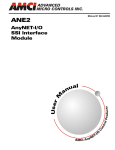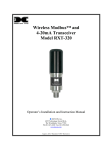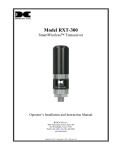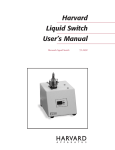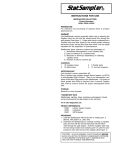Download Series 1400 Pulsatile Blood Pumps User`s Manual
Transcript
Series 1400 Pulsatile Blood Pumps User's Manual Model 1405 PBP for Rabbits Model 1407 PBP for Mice/Rats Model 1421 PBP for Dogs/Monkeys Model 1423 PBP for Large Animals; Hemodynamic Studies MA1 55-1838 MA1 52-9552 MA1 55-3321 MA1 55-3305 Publication 5413-001-REV-C WEEE/RoHS Compliance Statement EU Directives WEEE and RoHS To Our Valued Customers: We are committed to being a good corporate citizen. As part of that commitment, we strive to maintain an environmentally conscious manufacturing operation. The European Union (EU) has enacted two Directives, the first on product recycling (Waste Electrical and Electronic Equipment, WEEE) and the second limiting the use of certain substances (Restriction on the use of Hazardous Substances, RoHS). Over time, these Directives will be implemented in the national laws of each EU Member State. Once the final national regulations have been put into place, recycling will be offered for our products which are within the scope of the WEEE Directive. Products falling under the scope of the WEEE Directive available for sale after August 13, 2005 will be identified with a “wheelie bin” symbol. Two Categories of products covered by the WEEE Directive are currently exempt from the RoHS Directive – Category 8, medical devices (with the exception of implanted or infected products) and Category 9, monitoring and control instruments. Most of our products fall into either Category 8 or 9 and are currently exempt from the RoHS Directive. We will continue to monitor the application of the RoHS Directive to its products and will comply with any changes as they apply. • Do Not Dispose Product with Municipal Waste • Special Collection/Disposal Required Table of Contents Harvard Apparatus Series 1400 Pulsatile Blood Pumps User's Manual 1 SUBJECT PAGE NO. Warranty and Repair Information ........................2 Theory of Operation ..............................................3 Specifications ........................................................4 Operation: Installing the Pump ............................................5 Operation for All Pumps ....................................5 Operating Controls: Stroke Volume Adjustment ............................6 Rate Adjustment ............................................6 Output Phase Ratio........................................6 Dual Phase Rate Compensation Chart ..............7 Models 1405 & 1407: Pumping Head ..............................................8 Cleaning and Sterilization ..............................8 Lubrication ....................................................8 Valves ............................................................8 Pump Mechanism ..........................................8 Models 1421 & 1423: Pumping Head ..............................................9 Cleaning and Sterilization ..............................9 Lubrication ....................................................9 Valves ............................................................9 Pump Mechanism ..........................................9 Control ..........................................................9 Drawing and Parts List ..................................10-13 Diagrams ........................................................14-15 Data ......................................................................16 Publication 5413-001-REV-C Warranty and Repair Information 2 Harvard Apparatus Series 1400 Pulsatile Blood Pumps User's Manual Serial Numbers All inquires concerning our product should refer to the serial number of the unit(s). W a rr a n t y Harvard Apparatus warranties the instrument(s) for a period of two years from date of purchase.At its option, Harvard Apparatus will repair or replace the unit(s) if it is found to be defective as to workmanship or material. This warranty does not extend to damage resulting from misuse, neglect or abuse, normal wear and tear, or accident. This warranty extends only to the original customer purchaser. IN NO EVENT SHALL HARVARD APPARATUS BE LIABLE FOR INCIDENTAL OR CONSEQUENTIAL DAMAGES. Some states do not allow exclusion or limitation of incidental or consequential damages so the above limitation or exclusion may not apply to you. THERE ARE NO IMPLIED WARRANTIES OF MERCHANTABILITY, OR FITNESS FOR A PARTICULAR USE, OR OF ANY OTHER NATURE. Some states do not allow this limitation on an implied warranty, so the above limitation may not apply to you. If a defect arises within the two-year warranty period, promptly contact Harvard Apparatus, Inc. 84 October Hill Road, Holliston, Massachusetts 01746-1371 using our U.S. only toll free number 1-800-272-2775 or dial (508) 893-8999. Goods will not be accepted for return unless an RMA (returned materials authorization) number has been issued by our customer service department. The customer is responsible for shipping charges. Please allow a reasonable period of time for completion of repairs, replacement and return. If the unit is replaced, the replacement unit is covered only for the remainder of the original warranty period dating from the purchase of the original device. This warranty gives you specific rights, and you may also have other rights which vary from state to state. R e p a i r F a c i l i t i e s a n d P a rt s Harvard Apparatus stocks replacement and repair parts. When ordering, please describe parts as completely as possible, preferably using our part numbers. If practical, enclose a sample or drawing.We offer a complete reconditioning service. CAUTION: Not for clinical use on human patients. Publication 5413-001-REV-C Theory of Operation Harvard Apparatus Series 1400 Pulsatile Blood Pumps User's Manual 3 This family of four pumps, all similar in concept but differing in capacity, are intended to pump blood with minimum damage to blood cells. All pumps feature a mechanically activated piston moving back and forth in a transparent cylinder. The geometry of the piston actuation is such that the piston travels to the very end of the cylinder regardless of the stroke volume selected. This feature insures that blood is completely emptied from the cylinder at each stroke. The valve cages and liquid pathway have been carefully designed to provide a streamlined flow with no sharp edge to minimize hemolysis. All parts of the liquid pathway can be disassembled for cleaning and sterilization. In all pumps the volume per stroke and the strokes per minute can be adjusted while the pumps are running. The two smaller pumps #1405 and #1407 have mechanically fixed systole/diastole ratios of .33, that is, diastole lasts twice as long as systole. The larger pumps #1421 and #1423 have electronically variable ratios in which systole can be adjusted to be 25 to 50% of the total pumping cycle. Publication 5413-001-REV-C Specifications 4 Harvard Apparatus Series 1400 Pulsatile Blood Pumps User's Manual The specifications of all pumps are compared in the following chart. Harvard Pulsatile Blood Pump Comparison Chart Catalog No. 52-9552 55-1838 55-3321 55-3305 Model No. 1407 1405 1421 1423 Stroke Volume 0.05 to 1.0 ml 0.5 to 10.0 ml 4 to 30 ml 15 to 100 ml Stroke Rate (per min) 20 to 200 20 to 200 20 to 200 10 to 100 Minimum Volume (vol x rate) 1 to 200 ml 5 ml to 2.0 liters 80 ml to 6 liters 150 ml to 10 liters Phasing Fixed Phase 35% systole 65% diastole Fixed Phase 35% systole 65% diastole Adjustable Phase 35 to 50% of total cycle Adjustable Phase 35 to 50% of total cycle Tube Size (ID) 5/16 in 5/16 in 1/2 in 5/8 in Piston Diameter 1/4 in 3/4 in 1-1/8 in 2 in 5/16 in 1/2 in 5/8 in Ball Valve Diameter 5/16 in Dimensions 312 x 156 x 250 mm 312 x 156 x 250 mm 500 x 212 x 337 mm 500 x 212 x 337 mm (12.5 x 6.25 x 10 in) (12.5 x 6.25 x 10 in) (20 x 8.5 x 13.5 in) (20 x 8.5 x 13.5 in) Weight 7.3 kg (16 lb) 7.3 kg (16 lb) 13.6 kg (30 lb) 14.5 kg (32 lb) Power Used 50 W 50 W 85 W 85 W Voltage 115/230 V 50-60 Hz 115/230 V 50-60 Hz 115 V 50-60 Hz 115 V 50-60 Hz Application Mice/Rats Rabbits Dogs/Monkeys Large Animals; Hemodynamic Studies Publication 5413-001-REV-C Operation 5 Harvard Apparatus Series 1400 Pulsatile Blood Pumps User's Manual Installing the Pump Both of the smaller pumps #1405 and #1407 are equipped with a voltage selector switch for either 120 or 220 volt usage. BE SURE THIS SWITCH IS SET FOR YOUR VOLTAGE. For 220 volt operation the American line cord plug must be cut-off and an appropriate plug installed. The line cord is color coded in International standard colors. Brown – High Blue – Neutral Green – Ground Observe these polarities. PUMPS ARE NOT EXPLOSION PROOF. Operation for All Pumps The inlet nozzle is always at the bottom of the pump head. Pumps are self-priming and will lift liquids from reservoirs up to 50 centimeters below the inlet. Since the valves of the pump are passive ball valves liquid will flow thru the pump without the pump running if – 1. 2. 3. The inlet reservoir is above the outlet The inlet pressure is higher than the outlet pressure The outlet tubing is below the inlet, this can cause siphoning or gravity induced flow The volume pumped per minute is called the “minute volume”. It is the product of the stroke volume times the stroke rate. This is only valid if there is a normal amount of back pressure or resistance to flow. Since the pumped liquid has inertia, liquid will continue to flow even in the filling cycle. This can be prevented by having adequate resistance in the output circuit. Publication 5413-001-REV-C Operation 6 Harvard Apparatus Series 1400 Pulsatile Blood Pumps User's Manual O p e r a t i n g C o n t ro l s Stroke Volume Adjustment On smaller pumps the volume is set by turning the stroke volume control located at the top of the pump. Volume is read from the decal fastened to the pump cylinder. Volume is determined by watching the excursion of one “O” ring. Volume should be adjusted while the pump is running. A thumb screw is built-in to the volume control to provide positive locking once the volume is set. On larger pumps the volume control is at the top while the actual volume is read from a calibrated plate on the side of the pump. A locking knob next to the volume pointer provides positive locking. Rate Adjustment (strokes per min) On small pumps the rate control is at the top of the pump, on large pumps the rate control is at the end of the pump opposite the pump head. Output Phase Ratio The larger pumps are equipped with a control to adjust the ratio of systole to diastole. This control is located adjacent to the rate control. The control is continuously variable from 25/75 to 50/50. In the 25/75 position, systole takes place in 25% of the cardiac cycle while diastole takes place in 75%. This is observed by watching the piston/cylinder eject liquid quickly and fill slowly in the 25/75 position. In the 50/50 position the piston speed is the same in filling and emptying. The phase ratio has an affect on the rate control (see figure 1 on next page). The observed stroke rate varies considerably from the set rate as the phase ratio reaches its outer limits. Publication 5413-001-REV-C Operation 50 50/50 45/55 40/60 35/65 30/70 40 Actual rate in strokes per min Harvard Apparatus Series 1400 Pulsatile Blood Pumps User's Manual 7 25/75 30 20 10 0 0 10 20 30 40 50 Rate on strokes per min dial Figure 1. Dual Phase Rate Compensation Chart. Phase ratio (% systole); typical plot of actual stroke rate at various ratios and strokes. Publication 5413-001-REV-C Operation: Models 1405 & 1407 8 Harvard Apparatus Series 1400 Pulsatile Blood Pumps User's Manual C a re a n d M a i n t e n a n c e Disconnect from the power source before performing any motor maintenance. Pumping Head The Pumping Head is easily removed for cleaning, sterilization and lubrication. Refer to the diagram for part designation on the Standard 10 cc #1405 Pumping Head. Follow the instructions below for removing the Head: 1. 2. 3. 4. 5. Using the Stroke Rate and Stroke Volume Controls allow the Piston to recede to the furthest end of its travel. (Note:The stroke volume control should be set for maximum volume delivery). Remove the thumbscrews attaching the cylinder and the valve head. Gently pull the Cylinder away from the black plate until it clears the short binding posts extending from this plate. Slide the Head and Cylinder assembly off the piston. If Piston removal is desired, hold the Piston in one hand and use a small openend wrench to loosen the hex Coupling. The Piston can then be unscrewed from the Coupling. Cleaning and Sterilization For non-sterile applications, clean parts from all residues with water and a damp cloth. Flush the head and valves before reassembly to make sure that all cloth fibers and other materials are cleared. For sterile applications, either gas or cold sterilization agents can be used. Lubrication Apply a light coating of the silicone grease provided to the Piston and the inside of the Cylinder. Valves The Valves are easily disassembled for cleaning. The ‘O’ rings can be removed for cleaning and replacement. Refer to the drawing when the components are to be reassembled. Pump Mechanism The entire pump mechanism is available for inspection and lubrication by removing the bottom cover and the control panel assembly. The bottom cover is removed by loosening the screws within the four rubber feet. The control panel assembly is removed by (1) loosening the set screw on the Stroke Volume Control and removing the knob, (2) removing the eight Phillips-type screws connecting the panel assembly to the housing, and (3) lifting the panel assembly clear of the stroke control shaft. IMPORTANT: Make sure that the wires remain connected to their appropriate terminals. All bearings and points of frictional contact should be lubricated every 30 days with a light machine oil (Harvard Part No. 0606-060). Publication 5413-001-REV-C Operation: Models 1421 & 1423 9 Harvard Apparatus Series 1400 Pulsatile Blood Pumps User's Manual C a re a n d M a i n t e n a n c e Disconnect from the power source before performing any motor maintenance. Pumping Head The Pump Head is easily removed for cleaning, sterilization, and lubrication. Refer to diagrams for part designation on the #1421 and #1423 Pumping Heads, respectively. Follow the instructions below for removing the head: 1. 2. 3. Using the spanner wrench provided, insert the wrench-pin into one of the holes in the Nut-Coupling, apply pressure, and loosen. The coupling can now be easily removed from the cylinder. Using the same wrench, insert the wrench-pin into one of the holes on the cylinder, apply pressure, and loosen. Proceed to unscrew the cylinder manually. To remove the Piston, insert the wrench-pin into one of the holes on the Piston, apply pressure, and loosen. Remove the Piston manually. Cleaning and Sterilization For non-sterile applications, clean parts from all residues with water and a damp cloth. Make certain that all cloth fibers are cleared from the system before it is reassembled. For sterile applications, either gas or cold sterilization agents can be used. Lubrication Apply a light coating of the silicone grease provided to the Piston and the inside of the Cylinder. Valves The Valves are easily disassembled for cleaning. The ‘O’ rings can be removed for cleaning and replacement. Refer to the drawing when the components are to be reassembled. Pump Mechanism The entire Pump Mechanism is available for inspection and lubrication by removing the blank side panel. All bearings and points of frictional contact should be lubricated every 30 days with a light machine oil (Harvard Part No. 0606-060). Control The solid state dual phase Motor Control needs no special attention. If a problem seems to exist in the motor control, the unit should only be examined by a qualified technician. A safety fuse (1 amp. slo-blo type) is provided for overload protection. DO NOT REPLACE with a higher rated fuse. Publication 5413-001-REV-C Drawing and Parts List (1 cc) 10 Harvard Apparatus Series 1400 Pulsatile Blood Pumps User's Manual 1 c c S t a n d a rd P u m p i n g H e a d / 5 2 - 9 5 5 2 / 1 4 0 7 1405-046 5013-034 1405-043 1407-012 1407-013 1405-044 0 .5 1 0680-067 5013-016 5011-019 1405-045 Publication 5413-001-REV-C Part No. Replacement Part 0680-067 Coupling 1407-013 Piston 1405-044 Body–Valve 1405-045 Nozzle–Suction 1407-012 Cylinder 1405-046 Nozzle–Discharge 5011-019 Ball–SS Bearing, Hard 5013-016 O Ring, Parker #0125-070 5013-019 O Ring, Parker #2-13 1405-043 Head Drawing and Parts List (10 cc) 11 Harvard Apparatus Series 1400 Pulsatile Blood Pumps User's Manual 1 0 c c S t a n d a rd P u m p i n g H e a d / 5 5 - 1 8 3 8 / 1 4 0 5 1405-046 5013-034 1405-042 1405-011 1405-010 1405-044 0 .5 10 0680-067 5013-018 5011-019 1405-045 Publication 5413-001-REV-C Part No. Replacement Part 0680-067 Coupling 1405-010 Piston 1405-044 Body–Valve 1405-045 Nozzle–Suction 1405-046 Nozzle–Discharge 1405-042 Assy–Valve HD & Cylinder 5011-019 Ball–SS Bearing, Hard 5013-018 O Ring, Parker #2-16 5013-019 O Ring, Parker #2-13 Drawing and Parts List (30 cc) 12 Harvard Apparatus Series 1400 Pulsatile Blood Pumps User's Manual 3 0 c c S t a n d a rd P u m p i n g H e a d / 5 5 - 3 3 2 1 / 1 4 2 1 1401-033 5013-021 1401-010 5013-014 1401-014 5115-011 1401-032 1401-030 1401-015 1401-008 5124-001 1401-031 Publication 5413-001-REV-C 5013-032 Part No. Replacement Part 1401-008 Cylinder 1401-030 Head–Valve 1401-010 Nut–Coupling 1401-031 Nozzle–Suction 1401-032 Body–Valve 1401-033 Nozzle–Discharge 1401-014 Piston 1401-015 Shaft–Connecting 5013-014 O Ring, Parker #2-126 5013-021 O Ring, Parker #2-18 5013-032 O Ring, Parker #2-119 5115-011 Set Screw #8, 32 x 3/16 5124-001 Sphere, 1/2 D Drawing and Parts List (100 cc) 13 Harvard Apparatus Series 1400 Pulsatile Blood Pumps User's Manual 1 0 0 c c S t a n d a rd P u m p i n g H e a d / 5 5 - 3 3 0 5 / 1 4 2 3 1403-022 5013-037 1403-010 5013-028 1403-014 5115-011 1403-021 1403-019 1403-015 1403-008 5013-029 5124-002 1403-020 Publication 5413-001-REV-C Part No. Replacement Part 1403-008 Cylinder 1403-019 Head–Valve 1403-010 Nut–Coupling 1403-020 Nozzle–Suction 1403-021 Body–Valve 1403-022 Nozzle–Discharge 1403-014 Piston 1401-015 Shaft–Connecting 5013-028 O Ring, Parker #2-140 5013-029 O Ring, Parker #2-133 5013-037 O Ring, Parker #2-24 5115-011 Set Screw #8, 32 x 3/16 5124-002 Sphere, 3/4 D Diagrams 14 Harvard Apparatus Series 1400 Pulsatile Blood Pumps User's Manual Ty p i c a l P u m p H e a d Output Polycarbonate Nozzle Transparent Acrylic Valvecage Teflon Coated Piston Transparent Acrylic Chamber Transparent Acrylic Cylinder Silicone Ball-Check Valves Fluoro Elastomer “O” Rings Aluminum Coupling Nut Input Publication 5413-001-REV-C Publication 5413-001-REV-C Model No. 1405 1421 1421A 1423 1423A 1407 55-1838 55-3321 55-3339 55-3305 55-3313 52-9552 GROUND LUG MAIN CHASIS BLUE #18 Catalog No. GROUND LUG FRONT PANEL GREEN #18 GREEN/YELLOW #18 W1 PLUG AC MALE BROWN #18 F1 FUSE SLOW BLOW WHITE #18 115/240 VAC, 50–60 Hz (1 AMP) 240 VAC, 50 Hz (1/2 AMP) 115 VAC, 60 Hz (1 AMP) 240 VAC, 50 Hz (1/2 AMP) 115 VAC, 60 Hz (1 AMP) 115/240 VAC, 50–60 Hz (1 AMP) Power S1 POWER SWITCH BLACK BLACK PILOT LIGHT DS1 BLACK #18 BLACK 100K SPEED GREEN VR101 RED L1 S1 S2 S3 L1 L2 A1 F1 BLUE #18 BLUE #18 A2 MC1 F2 M1 MOTOR BLACK #18 BLACK #18 Harvard Apparatus Series 1400 Pulsatile Blood Pumps User's Manual Diagrams 15 S i n g l e P h a s e M o t o r S p e e d C o n t ro l (Models 1405 & 1407) Data 16 Harvard Apparatus Series 1400 Pulsatile Blood Pumps User's Manual H e m o l y s i s Te s t D a t a ( M o d e l s 1 4 2 1 & 1 4 2 3 ) In these studies a reservoir of 500 to 800 cc of fresh dog blood was used, connected to the pump by 3/8" PVC tubing. Samples at room temperature were taken at 15 and 30 minute intervals for 4 to 5 hours. Samples were spun down and hemolysis measured immediately using the method of FLINK & WATSON. Since the rate of hemolysis depends on the amount of blood in the system and the flow rate, the results are reported as mg % per pass. The flow rate divided by the volume of blood in the system determines the number of passes through the pump per minute. Hemolysis ranged from 0.114 mg % to 0.27 mg % per hour pass through the various pumps with an error of ± 10%. To put these results in perspective most physiological perfusions are run with flow rates and total blood primes, so that the number of passes through the pump will range from about 1/4 to 3/4 per minute. Assuming one pass in two minutes and no physiological removal of the products of hemolysis, then hemolysis rates would range from 3.4 mg % to 8.7 mg % per hour of pump use. Publication 5413-001-REV-C























